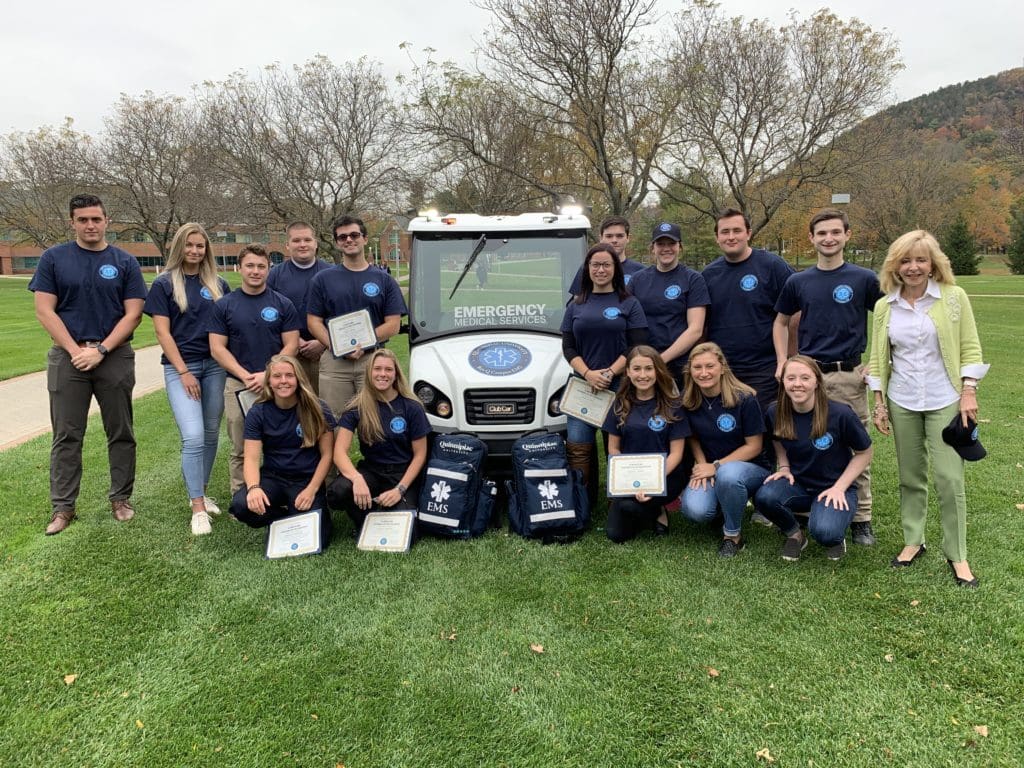[promo_content slug=”rodriguez-dec-2020-csos-promo”]
When Edgar Rodriguez first arrived at Quinnipiac University in 2010, the current public safety department did not exist. The “department” was referred to as a security unit and was partially patrolled by a private security firm. It was run without policies, procedures or directives, and nearly all equipment was antiquatedp.
“There was no training, and there was a lack of technology and camera equipment,” says James Nealy, assistant chief of public safety at Quinnipiac. “The vehicles were old, dilapidated and undependable and the relationship with the student body, Hamden Town residents, and Hamden Police and Fire was very poor.”
Rodriguez, who has more than 32 years of law enforcement experience, including 22 years with the Connecticut State Police, was up to the challenge of transforming the security unit into an in-house public safety department. Through a 12-part phased approach, he tackled the aforementioned concerns, among many others.
“Upon realizing the enormous job ahead of him in professionalizing the department and making department members more responsive to the needs of a rapidly growing campus, he set in motion a strategic plan to improve and transform the department to what it is today – a model public safety department,” Healy says.
The results of Rodriguez’s efforts are impressive and the reason why he has been named this year’s Higher Education Director of the Year.
Before embarking on the arduous journey of completely reimagining campus safety and security at Quinnipiac, Rodriguez had the department evaluated by Margolis Healy and Associates, a consulting firm specializing in safety, security, emergency preparedness and compliance. In doing so, the firm informed him that it was the first department they had evaluated as a result of a self-initiated request. He was praised for his forward vision, strategic planning and transformational leadership.
While all aspects of his approach to establishing an in-house department are notable, perhaps the most impressive are his initiatives to attract the right employees, create new positions that focus on specific aspects of campus security, and provide thorough, top-of-the-line training.
Chief Creates New Positions, Programs to Improve Safety and Security
Once the unit officially became a proprietary security department, a new employee selection process was initiated within the HR department to attract a professional and highly trained team. Competitive salaries were implemented, and a new employee tracking and scheduling system was also put into place.
Almost immediately, Rodriguez hired 20 additional personnel and two investigators to beef up the department. Before he joined the team, the department used head officers. Once Rodriguez came into the picture, eight supervisor and sergeant positions were added to oversee officers.
A new fire marshal position was also created and made responsible for the development of written fire prevention plans for both regular and after-hours. In the event of a fire affecting the university, Rodriguez created a system that sends notifications to the Hamden Fire Department and the senior vice president for administration. It has led to the successful integration of the fire prevention plan with the existing emergency plan. Additionally, it led to the creation and distribution of procedures to all employees and students on reporting a fire, the location of fire exits and evacuation routes.
Rodriguez also recognized that the department was in desperate need of an investigative unit to work with the university and as a liaison with local, state and federal law enforcement agencies. Established during the 2013-2014 academic year, the unit investigates Clery and Title IX incidents, internal affairs, student conduct, drugs, assaults, domestic violence and thefts, among other things.
To improve parking safety, a parking and transportation coordinator was hired to oversee transportation between the three campuses and parking ticket collections. A graduate assistant was also hired to support the coordinator, and online visitor passes and parking permits were established.

The Res-Q Campus Emergency Medical Service Program, established by Rodriguez, helps students who are medical technicians meet their patient contact hours while also helping make Quinnipiac safer for all.
Through presentations and meetings, Rodriguez was also able to convince directors, students, parents, staff and the local police department of the need for an armed component within the department, which was implemented in late 2014. All armed officers are retired from sworn local, state and federal departments and are required to pass a psychological exam, be retired in good standing, pass an entry-level police background check, and comply with and meet all of Connecticut’s certification standards.
Rodriguez also worked to involve students in improving campus safety by establishing the Res-Q Campus Emergency Medical Service Program in 2019. The program, a volunteer service staffed by Quinnipiac students who are emergency medical technicians, is licensed by the state of Connecticut to provide emergency medical services on the Mount Carmel and York Hill campuses. It allows healthcare students to supplement their patient contact hours without having to leave campus. According to Rodriguez, there are only 250 colleges and universities that have EMS programs.
To support and motivate new and existing employees, Rodriguez issued new uniforms and badges that helped professionalize the department. He was also able to secure new vehicles fully equipped with emergency lights, data terminals, and improved radios and emergency evacuation equipment. Furthermore, Rodriguez consistently updated the department’s technology, software and radio communications, including an automated telephone system in 2015, a new visitor management check-in system in 2016, body cameras for officers in 2017, and the installation of at least 310 IP cameras from 2015 to present day.
“The installation of cameras and other technologies spearheaded by Chief Rodriguez served to enhance campus safety and surveillance capabilities,” says Nealy. “Coupling this technology with our campus community engagement has allowed us to prevent and solve several cases not only for our department but for the local police department.”
Rigorous Training Requirements Established
Additional hires were needed to make the new department run effectively, but for Rodriguez, the number of employees didn’t matter if there weren’t solid training requirements in place. He created a seven-week field officer training program from scratch and established new state-sanctioned training programs. There are three full-time law enforcement trainers at the university whose sole responsibility is to continually train officers.
This program has led to increased efficiency in report writing, investigations and Clery documentation, increased knowledge and skills on computer access and usage, an increase in knowledge of campus buildings and structures, an increase in operational knowledge of emergency protocols, assignments and alarms, and increased customer service practices. It has also prepared staff to engage with the diverse student body through ongoing conversations and support.
All sergeants are trained in frontline supervision, leadership ethics, threat and risk assessment, active shooter awareness, impartial bias and use-of-force, just to name a few. The team also holds monthly sergeant meetings and does an annual review of all Connecticut statutes, policies and procedures.
Any and all armed officers are also trained in report writing, campus security authorities, defensive tactics, improvised explosive devices, domestic violence, sexual assault and rape crisis, drug recognition, CPR/First Aid and defensive training. Their training is integrated with the Hamden Police Department, the North Haven Police Department and the Connecticut State Police.
To provide Quinnipiac officers with further training while also helping the surrounding community, the school also participates in and hosts DHS’ “Live Action Shooter” training for local, state and federal law enforcement agencies. Additionally, the school hosts tabletop exercises with local, state and federal agencies in North Haven.
Realizing the importance of including additional stakeholders, Rodriguez organized and established the university’s emergency management team. The team, which meets monthly and is made up of 11 administrators, oversees various facets of responding to a crisis on all three campuses, including planning, operations, logistics, public information and internal communications.
Team members complete FEMA’s National Incident Management System (NIMS) training and participate in tabletop exercises. They have also developed and implemented an emergency evacuation plan for People’s United Center, located on the York Hill campus. Every year, the team conducts tabletop exercises with local, state and federal agencies, and carries out emergency management program assessments.
“[Rodriguez] ensures that personnel engage and work constructively with other departments and stakeholders,” Nealy says. “He guarantees that a culture of ongoing professionalism and training is infused into the culture of the public safety office.”













